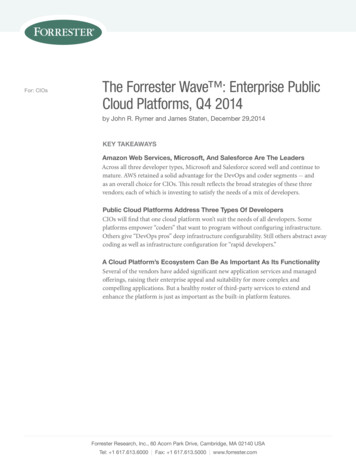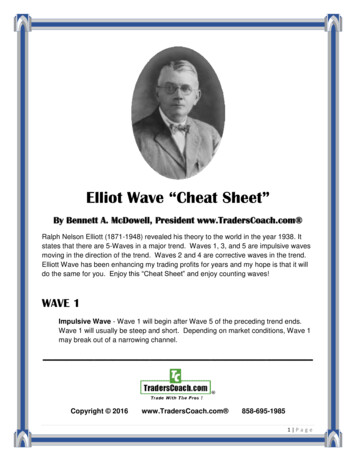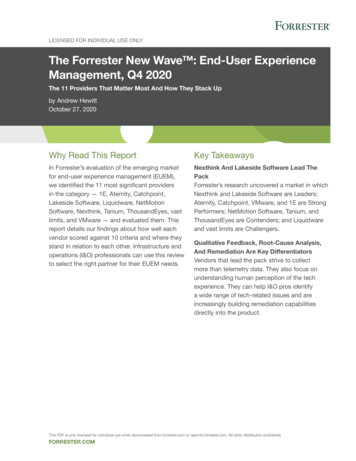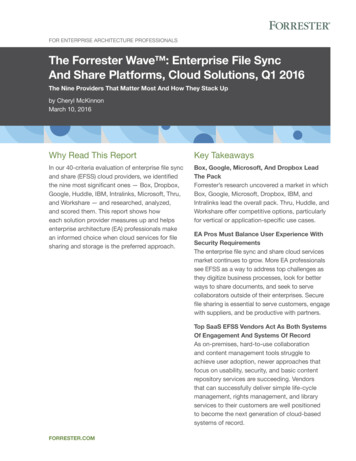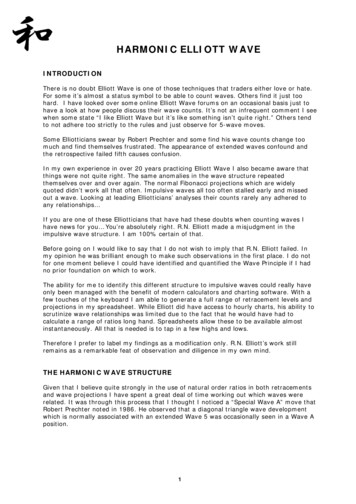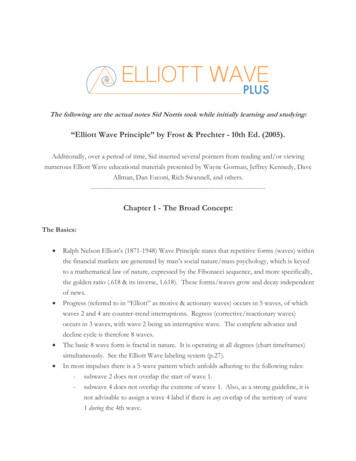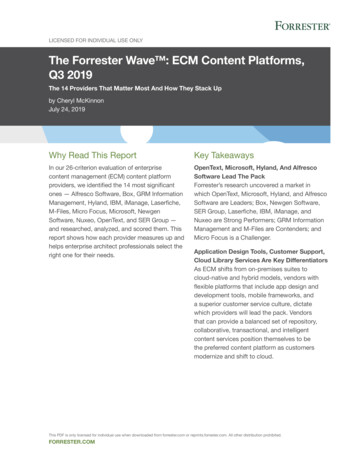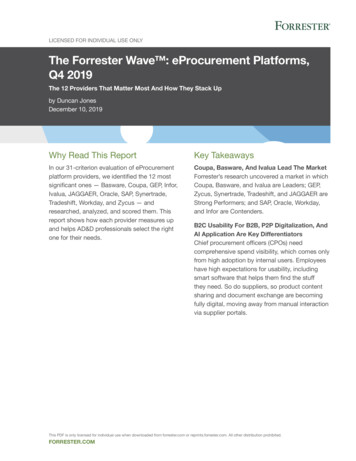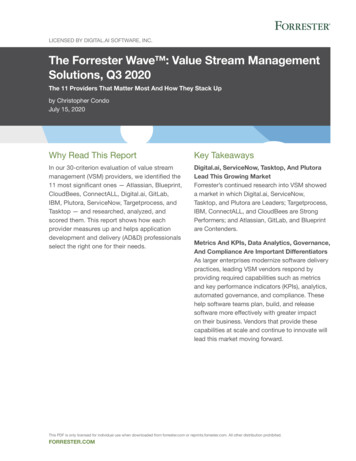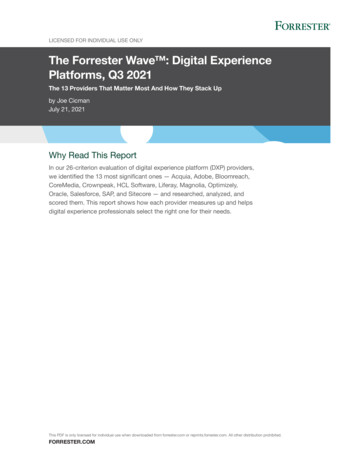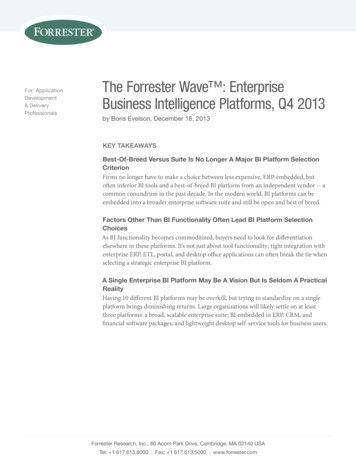
Transcription
For: ApplicationDevelopment& DeliveryProfessionalsThe Forrester Wave : EnterpriseBusiness Intelligence Platforms, Q4 2013by Boris Evelson, December 18, 2013KEY TAKEAWAYSBest-Of-Breed Versus Suite Is No Longer A Major BI Platform SelectionCriterionFirms no longer have to make a choice between less expensive, ERP-embedded, butoften inferior BI tools and a best-of-breed BI platform from an independent vendor -- acommon conundrum in the past decade. In the modern world, BI platforms can beembedded into a broader enterprise software suite and still be open and best of breed.Factors Other Than BI Functionality Often Lead BI Platform SelectionChoicesAs BI functionality becomes commoditized, buyers need to look for differentiationelsewhere in these platforms. It’s not just about tool functionality; tight integration withenterprise ERP, ETL, portal, and desktop office applications can often break the tie whenselecting a strategic enterprise BI platform.A Single Enterprise BI Platform May Be A Vision But Is Seldom A PracticalRealityHaving 10 different BI platforms may be overkill, but trying to standardize on a singleplatform brings diminishing returns. Large organizations will likely settle on at leastthree platforms: a broad, scalable enterprise suite; BI embedded in ERP, CRM, andfinancial software packages; and lightweight desktop self-service tools for business users.Forrester Research, Inc., 60 Acorn Park Drive, Cambridge, MA 02140 USATel: 1 617.613.6000 Fax: 1 617.613.5000 www.forrester.com
FOR APPLICATION DEVELOPMENT & DELIVERY PROFESSIONALSDECEMBER 18, 2013The Forrester Wave : Enterprise BusinessIntelligence Platforms, Q4 2013The 11 Providers That Matter Most And How They Stack Upby Boris Evelsonwith Holger Kisker, Ph.D., Martha Bennett, and Nasry AngelWHY READ THIS REPORTIn Forrester’s 72-criteria evaluation of enterprise business intelligence (BI) platform vendors, weidentified the 11 most significant software providers — Actuate, IBM, Information Builders, Microsoft,MicroStrategy, Oracle, QlikTech, SAP, SAS, Tableau Software, and Tibco Software — in the category andresearched, analyzed, and scored them. This report details our findings about how well each vendor fulfillsour criteria and where they stand in relation to each other to help application development and deliveryprofessionals select the right partner for their enterprise BI platforms.Table Of ContentsNotes & Resources2 Industry Leaders Compete On InformationForrester conducted product evaluations inSeptember 2013, interviewed 10 vendors,and surveyed 94 user companies.The BI Software Market Is Becoming MoreCrowded Every YearTrue Vendor Differentiation Lies In The DetailsRelated Research Documents7 Enterprise BI Platform Evaluation OverviewMarket Overview: Mobile BusinessIntelligenceOctober 28, 2013Evaluation Criteria: Current Product Offering,Strategy, And Market PresenceEvaluated Vendors Have What It Takes ToSupport BI In Complex Organizations10 BI Is A Buyers’ Market That Offers Plenty OfChoices12 Vendor ProfilesLeadersStrong Performers17 Supplemental MaterialTechRadar : BI Analytics, Q3 2013July 11, 2013Decide When To Buy, Build, Or Outsource BIAugust 23, 2012The Forrester Wave : Advanced DataVisualization (ADV) Platforms, Q3 2012July 17, 2012The Forrester Wave : Self-Service BusinessIntelligence Platforms, Q2 2012June 12, 2012 2013, Forrester Research, Inc. All rights reserved. Unauthorized reproduction is strictly prohibited. Information is based on best availableresources. Opinions reflect judgment at the time and are subject to change. Forrester , Technographics , Forrester Wave, RoleView, TechRadar,and Total Economic Impact are trademarks of Forrester Research, Inc. All other trademarks are the property of their respective companies. Topurchase reprints of this document, please email clientsupport@forrester.com. For additional information, go to www.forrester.com.
FOR APPLICATION DEVELOPMENT & DELIVERY PROFESSIONALS2The Forrester Wave : Enterprise Business Intelligence Platforms, Q4 2013INDUSTRY LEADERS COMPETE ON INFORMATIONThe majority of large organizations have either already shifted away from using BI as just another backoffice process and toward competing on BI-enabled information or are in the process of doing so.Businesses can no longer compete just on the cost, margins, or quality of their products and services inan increasingly commoditized global economy. Two kinds of companies will ultimately be moresuccessful, prosperous, and profitable: 1) those with richer, more accurate information about theircustomers and products than their competitors and 2) those that have the same quality of informationas their competitors but get it sooner. Forrester’s Forrsights Strategy Spotlight: Business IntelligenceAnd Big Data, Q4 2012 survey showed that enterprises that invest more in BI have higher growth.The BI Software Market Is Becoming More Crowded Every YearThe software industry recognized this trend decades ago, resulting in a market swarming withstartups that appeared and (very often) found success faster than large vendors could acquire them.The market is still jam-packed and includes multiple dynamics: All ERP and software stack vendors offer leading BI platforms . . . Stack or suite versusbest of breed is no longer a consideration. All large software stack and enterprise resourceplanning (ERP) vendors have either built or acquired market-leading BI platforms. The paceof acquisition has not slowed: In the past few years, Oracle has acquired Endeca, SAP acquiredKXEN, and IBM acquired i2, The Now Factory, Star Analytics, and StoredIQ. Forrsights dataindicates that these three stack vendors, along with Microsoft, are currently the most popular BIchoices for companies. . . . but there’s also plenty of room for independent BI vendors. If your sourcing and vendormanagement policy calls for diversification and less dependence on a single vendor, rest easy —you have abundant options. SAS and Information Builders deliver one-stop BI shopping and offernot just BI, but also most of the data management platforms and tools. Actuate and MicroStrategyoffer reporting and analytics platforms that can scale to the needs of large enterprises. PanoramaSoftware, QlikTech, Tableau Software, and Tibco Software provide differentiated, highly visual,intuitive analytics oriented toward business users. Forrester clients are taking notice: Tableau andQlikTech rank among the top five vendors mentioned in the BI-related inquiries that we’ve fieldedin the past 12 months (see Figure 1). Departmental desktop BI tools aimed at business users are scaling up. Panorama Software,QlikTech, Tableau Software, and Tibco Software started out by offering departmental desktopbased technologies that appealed to business users due to their ease of use and lesser relianceon enterprise IT support. While that appeal is still there, these vendors are now going afterlarge enterprises with features that challenge larger vendors in terms of scalability, security,rich metadata, internationalization, application programming interfaces (APIs), and otherindustrial-strength enterprise features. 2013, Forrester Research, Inc. Reproduction ProhibitedDecember 18, 2013
FOR APPLICATION DEVELOPMENT & DELIVERY PROFESSIONALS3The Forrester Wave : Enterprise Business Intelligence Platforms, Q4 2013 Enterprise BI platform vendors are going after self-service use cases. Large enterprise BIplatform vendors aren’t sitting on their laurels; they’re prioritizing investments in self-service,in-memory, desktop, and cloud products that appeal to business users. Because these tools arepart of larger, more complete enterprise BI platforms, vendors often give them away for free; forexample, you get IBM Cognos Insight if you have Cognos 10 enterprise licenses, SAP Lumira ifyou buy the BusinessObjects BI suite, or the self-service BI features in Microsoft Excel 2013 likePower Pivot, Power View, Power Map, and Power Query if you have Microsoft Office 2013 orSharePoint 2010. These vendors have an additional advantage: IT can migrate self-provisionedBI applications to their more scalable platform. This puts a lot of pressure on the vendors in thedepartmental category. Cloud offers options to organizations that would rather not deal with BI stack complexity.Got data, want information, but don’t want to deal with installation, configuration, integration,tuning, optimization, maintenance, and support? Large vendors such as Actuate, Microsoft,MicroStrategy, SAP, Tableau Software, and Tibco Software and native cloud BI vendors like Birst,Bime, and GoodData offer very attractive choices for such use cases. Hadoop is breathing new life into open source BI. Open source BI tools have been aroundfor years, but big data and Hadoop are now re-energizing these products. If you have limitedbudget, want to reduce your dependence on commercial software vendors, and want toleverage the expertise of millions of software developers around the world, look to ActuateBIRT, Jaspersoft, Pentaho, and SpagoBI. Large BI systems integrators (SIs) are also respondingto clients’ demands to reduce their dependence on commercial code and vendors and haverecently started building open source BI solutions for clients — such as Luxoft’s Horizon datavisualization platform. Self-service BI takes on a new meaning. Business users are no longer satisfied with justdiscovering and analyzing data; they’re also asking for the ability to perform basic datamanipulation tasks like integration, matching, and deduplication without having to wait forenterprise batch extract-transform-load (ETL) and data cleansing cycles. SAP built thesefeatures into Lumira; Actuate acquired functionality from Quiterian that it now offers as BIRTAnalytics; and Tableau Software and QlikTech partner with Paxata. Alteryx, Microsoft (via theBI features in Excel 2013), and Prognoz also support this use case out of the box. The line between BI software and services is blurring. Leading consultants and SIs are ridingthe BI wave, getting into BI outsourcing deals where they take on the burden of managing aclient’s data and providing information-as-a-service, often hiding architecture and softwarecomplexities from the client.1 2013, Forrester Research, Inc. Reproduction ProhibitedDecember 18, 2013
FOR APPLICATION DEVELOPMENT & DELIVERY PROFESSIONALS4The Forrester Wave : Enterprise Business Intelligence Platforms, Q4 2013The BI use cases and vendors cited above don’t even come close to comprising a complete list.Other use cases include lightweight BI platforms that lend themselves to embedding into otherapplications, prebuilt components that can be quickly assembled into use case-specific BI apps, andextracting data from exotic data sources such as mainframe reports. Other vendors in the spaceinclude arcplan, Bitam, Board International, Datawatch, Dimensional Insight, InetSoft Technology,JackBe (Software AG), Jinfonet Software, Logi Analytics, Looker, Rocket Software, SalientManagement, SiSense, Targit, Treasure Data, and Yellowfin.Figure 1 How Organizations Use And Inquire About Leading BI VendorsRank in thenumber ofBI inquiriesSAP“Which vendors’ BI tools do you currently use?”*1Microsoft2 (tie)MicrosoftTableau Software2 7SAS8Actuate9Information Builders10Tibco eau Software14%9%6%5%Tibco Software4%Information Builders4%Actuate4%Base: BI-related inquiries by Forresterclients over the past 12 monthsBase: 634 IT executives and technology decision-makers(multiple responses accepted)*Source: Forrsights Strategy Spotlight: Business Intelligence And Big Data, Q4 2012108103 2013, Forrester Research, Inc. Reproduction ProhibitedSource: Forrester Research, Inc.December 18, 2013
FOR APPLICATION DEVELOPMENT & DELIVERY PROFESSIONALS5The Forrester Wave : Enterprise Business Intelligence Platforms, Q4 2013True Vendor Differentiation Lies In The DetailsEvaluating, categorizing, and ranking 30 or more BI vendors is a daunting task. As a result, in thisForrester Wave we concentrated on evaluating core BI capabilities such as:2 Advanced data visualization. ADV supports a wide range of new, interactive graphicaldata representations beyond traditional bar charts, pie charts, and scorecards. It differs fromstatic charts via capabilities such as the autosuggestion of the best chart type based on dataand metadata; visual querying; dynamically changing content; multiple dynamically linkedvisualization panels; custom-built chart types; and personalization. When evaluating BI vendorADV capabilities, look for features like animations, geospatial integration, the ability to handlemultiple dimensions, exploration and data discovery, storyboarding, and visual querying.3 Analysis or OLAP. Otherwise known as “slicing and dicing” analysis, online analyticalprocessing (OLAP) tools allow a user to almost instantaneously regroup, reaggregate, and resort facts — typically additive numbers like transaction amounts and account balances — byany dimension (usually a descriptive element like time, region, organizational unit, or productline). When evaluating BI vendor OLAP capabilities, look for features like limits on dimensionsand hierarchies; cube sizes; the ability to drill up, down, across, and through the data; andautogeneration of time series data. Exploration and discovery. This is analysis with a twist. Analysis typically only provides answersto questions that have been modeled and prebuilt in an underlying relational or multidimensionaldata model. With data exploration, no data modeling is required; all entities and attributes areinstantly cross-referenced and correlated with each other. No relational or multidimensionalmodel is built; every attribute can be used as a fact or as a dimension; and a micromodel is built atthe time of querying. When evaluating BI vendor exploration and discovery capabilities, look forfeatures like the ability to reuse any element as a fact or dimension; the ability to search for anyvalue or text anywhere in the model; and faceted navigation.4 Dashboards. Dashboards are interactive visualizations that mash up different historical, current,and/or predictive information into one efficient graphical user interface (GUI). Typically,dashboards display key performance indicators (KPIs) and use visual cues to focus userattention on important conditions, trends, and exceptions. Performance management. Strategy and performance management address goals, objectives,and accountability. Performance analytics typically use a variety of KPIs that might includestrategic scorecards; relevant comparisons against plans, budgets, forecasts, prior performance,and industry benchmark data; and the ability to drill down to root-cause details. Whenevaluating BI vendor performance management capabilities, look for embedded functionalityand tight integration with other performance management platforms. 2013, Forrester Research, Inc. Reproduction ProhibitedDecember 18, 2013
FOR APPLICATION DEVELOPMENT & DELIVERY PROFESSIONALS6The Forrester Wave : Enterprise Business Intelligence Platforms, Q4 2013 Predictive analytics. Predictive analytics represent any solution that supports the identificationof meaningful patterns and correlations among variables in complex, structured, unstructured,historical, and potential future data sets for the purposes of predicting events and assessingthe attractiveness of various courses of action. When evaluating BI vendor predictive analyticscapabilities, look for aspects like how many routines come out of the box, how tightly they’reintegrated with the rest of the BI platform, and whether the vendor integrates open source R.5 Reporting and querying. This includes analytical reporting based on a data warehouse(DW) or data mart and operational reporting based on an operational database managementsystem. Reporting tools often include pixel-perfect positioning of data and graphics, a scriptinglanguage equal in power to a full programming language, and the ability to handle complexheaders, footers, nested subtotals, and multiple report bands on a single page. Ad hoc querytools provide quick answers to business questions. When evaluating BI platform reportingcapabilities, look for features like report formatting (including conditional formatting), profilebased customization, grouping, ranking, sorting, filtering, and expanding and collapsing reports.We also looked at the information delivery capabilities of these tools, such as: Embedded BI. Embedded reporting, analytics, and dashboards are purpose-built analyticscapabilities that are embedded into other business applications, such as ERP, CRM, and supplychain management (SCM), either natively, via a software development kit or API, or via serviceoriented architecture (SOA) or web services. Integration with Microsoft Office applications. While all leading BI platforms integrate withMicrosoft Word, PowerPoint (for documents and presentations that use “live” data), and Excel(for viewing secure and trusted corporate data), very few provide tight integration with emailbeyond emailing reports or report URLs. Organizations can embed BI dashboards into an emailapplication — for example, by creating another panel in Outlook similar to its existing mail,calendar, and task panels. Further customizations make the data more actionable; for example,an email from a certain customer could proactively expose a dashboard about that customer. Portal integration. Portals may serve as a single access point to catalog and index, classify,and search for BI objects such as dashboards and reports. Most BI platforms come with theirown portals, but organizing multiple BI applications based on different platforms under oneportal umbrella requires legwork. Organizations can apply enterprise portal standards to all BIapplications and expose all BI metadata to the portal search engine to allow users to search forall BI content from a single point. Thick and thin clients. These include native desktop and mobile device client applications,applications accessible via any Internet browser, and rich Internet applications that usestandards like HTML5. 2013, Forrester Research, Inc. Reproduction ProhibitedDecember 18, 2013
FOR APPLICATION DEVELOPMENT & DELIVERY PROFESSIONALS7The Forrester Wave : Enterprise Business Intelligence Platforms, Q4 2013 Other report and dashboard dissemination capabilities. Even though interactive desktop andmobile BI applications are becoming more popular, many organizations still need to schedulebatch reports and deliver them automatically to multiple devices via email, electronic datainterchange, and other electronic formats.And we didn’t forget to evaluate the integration of BI tools with foundational, supportingcomponents such as: Applications. Look for the number of “hooks” (APIs) into various programming languages thatyou can use to customize or execute platform functions. This is key for embedded BI, whitelabeled BI applications, and the integration of BI with any other platforms. Data. Most BI platforms come with basic data integration (ETL) functionality. Beyond that,look for certified integration with leading data integration platforms.6 Contextual services. BI output is only as good as the source data. Look for certified integrationwith data quality (DQ) and master data management (MDM) platforms. Technical architecture. Last but not least, consider technical architecture features such as 64-bit architectures, client and server platforms, application server support, SOA certification, andfeatures needed to scale up and out.The detailed list of BI platform capabilities and features is much, much longer. As part of the researchconducted for this Forrester Wave, Forrester collected more than 300 data points from each vendorand consolidated them into 72 criteria. We used those criteria to evaluate, score, and rank the vendors.ENTERPRISE BI PLATFORM EVALUATION OVERVIEWTo assess the state of the market for enterprise business intelligence platforms and see how the vendorsstack up against each other, Forrester evaluated the strengths and weaknesses of top BI vendors.Evaluation Criteria: Current Product Offering, Strategy, And Market PresenceAfter examining past research, user needs assessments, and vendor and expert interviews, wedeveloped a comprehensive set of evaluation criteria. We evaluated vendors against 72 criteria,which we grouped into three high-level buckets: Current offering. We assessed each vendor’s current offering by considering all of the featuresand capabilities reviewed above. We also evaluated a short demonstration by each vendor of itskey capabilities and surveyed a total of 94 of the vendors’ customers. 2013, Forrester Research, Inc. Reproduction ProhibitedDecember 18, 2013
FOR APPLICATION DEVELOPMENT & DELIVERY PROFESSIONALS8The Forrester Wave : Enterprise Business Intelligence Platforms, Q4 2013 Strategy. We reviewed each vendor’s strategy and considered how well each vendor’s plansfor product enhancement position it to meet future customer demands. We also looked atthe financial and human resources the company has available to support its strategy and eachvendor’s go-to-market pricing and licensing strategy. Market presence. To establish a product’s market presence, we combined information abouteach vendor’s financial performance, installed customer base, and number of employees acrossmajor geographical regions with information about its partnership ecosystem and its horizontaland vertical industry applications.Evaluated Vendors Have What It Takes To Support BI In Complex OrganizationsForrester included 11 vendors in the assessment: Actuate, IBM, Information Builders, Microsoft,MicroStrategy, Oracle, QlikTech, SAP, SAS, Tableau Software, and Tibco Software. Oracle wasincluded as a nonparticipating vendor. Each of these vendors has (see Figure 2): A complete, self-contained, fully functional BI platform development environment. Wefocused on BI tools not technologically or functionally tied or limited to particular functionalor horizontal applications like ERP or SCM. These tools must be complete, self-contained BIenvironments or platforms that do not necessarily have to be embedded into other applications. The ability to query databases using SQL and MDX. While other querying technologies, suchas XQuery and DMX, are available and NoSQL data architecture is on the rise for certain BI usecases, SQL and MDX are the database query technologies most widely used in large enterprises. Sufficient market presence and interest from Forrester clients. We included the top 11vendors by BI revenue that also had at least 100 in-production customers and were present inmore than one major geographical region. We also focused on vendors that Forrester clientsfrequently mentioned or asked about in the context of BI (measured as more than 25 inquiriesover the past 12 months). 2013, Forrester Research, Inc. Reproduction ProhibitedDecember 18, 2013
FOR APPLICATION DEVELOPMENT & DELIVERY PROFESSIONALS9The Forrester Wave : Enterprise Business Intelligence Platforms, Q4 2013Figure 2 Evaluated Vendors: Product Information And Selection CriteriaVendorProductVersionActuateBIRT iHubBIRT Analytics3IBMCognos BICognos Insight10.2.1Information BuildersWebFocus8.0MicrosoftSQL ategyMicroStrategy Analytics Platform9.4OracleOracle Business IntelligenceEnterprise Edition11QlikTechQlikView11SAPBusinessObjects BI SuiteLumira4.1SASEnterprise BI ServerVisual AnalyticsOffice Analytics4.46.25.1Tableau SoftwareDesktopServerPublic8.1Tibco SoftwareSpotfire PlatformSpotfire CloudSpotfire Event Analytics6.0Source: Forrester Research, Inc. 2013, Forrester Research, Inc. Reproduction ProhibitedDecember 18, 2013
FOR APPLICATION DEVELOPMENT & DELIVERY PROFESSIONALS10The Forrester Wave : Enterprise Business Intelligence Platforms, Q4 2013Figure 2 Evaluated Vendors: Product Information And Selection Criteria (Cont.)Vendor selection criteriaAt least three of the four major functional BI components that Forrester believes are critical for largeenterprise BI environments: production and operational reporting, ad hoc querying, OLAP, anddashboards.The ability to query databases using SQL and MDX. While other querying technologies such asXQuery and DMX are available, SQL and MDX are used most widely in large enterprises.A complete, self-contained, fully functioning BI environment that is not technologically or functionallytied or limited to particular functional or horizontal applications like ERP or SCM. To be considered, atool must be a complete, self-contained BI environment or platform that does not have to beembedded in other applications.Significant market presence: at least 100 in-production customers present in more than one majorgeographical region and more than 10% of which are enterprise-grade installations that cross lines ofbusiness and have more than 100 users.Frequent interest from Forrester clients in the form of questions about or mentions of a vendor in thecontext of inquiries about BI.One of the top 11 vendors by BI revenues.All products needed to be generally available by December 2013.Source: Forrester Research, Inc.BI IS A BUYERS’ MARKET THAT OFFERS PLENTY OF CHOICESThe evaluation uncovered a continuously evolving market in which (see Figure 3): SAP, IBM, SAS, Microsoft, Oracle, Information Builders, MicroStrategy, and Actuate leadthe pack. While many BI platform features are becoming commoditized, it’s not the individualcapabilities that differentiate the Leaders, but rather the completeness, comprehensiveness, andintegration of the entire BI architectural stack. In addition to increasingly popular featureslike analytics, data visualization, dashboards, and data exploration, the Leaders also providethe pixel-perfect, industrial-strength report writers that companies still need.7 While many ofthe Leaders appear to be closely grouped, each of them differentiates itself in terms of specificindividual capabilities, such as high scalability and tight integration with ETL, MDM, businessperformance solutions, portals, and other highly relevant data management and informationdelivery components. If one of our Leaders is already your enterprise’s preferred BI platformprovider, there may be little or no reason to look elsewhere for another specialized BI tool. 2013, Forrester Research, Inc. Reproduction ProhibitedDecember 18, 2013
FOR APPLICATION DEVELOPMENT & DELIVERY PROFESSIONALS11The Forrester Wave : Enterprise Business Intelligence Platforms, Q4 2013 Tibco Software, QlikTech, and Tableau Software offer highly competitive and differentiatedoptions. Vendors in the Leaders category can by no means rest easy: the Strong Performers arehot on their heels, especially where the main use case calls for business user self-service andhighly visual and intuitive analytics. In many specialized situations, these vendors can evenoutshine and outperform the Leaders. Tibco Spotfire leads the market in highly visual streaminganalytics and business activity monitoring, tightly integrating it with process workflows, rules,and advanced analytics to help enable the modern real-time enterprise. QlikView is hard to beatin intuitive and spontaneous data exploration and discovery, providing a unique solution to theage-old BI challenge “You don’t know what you don’t know.” Tableau Software’s differentiationgoes well beyond technology: Its platform embeds most of the best practices that address thehuman psychology of visual perception to produce the most intuitive visualizations.This evaluation of the enterprise BI platform market is intended to be a starting point only. Weencourage clients to view detailed product evaluations and adapt criteria weightings to fit theirindividual needs through the Forrester Wave Excel-based vendor comparison tool.Figure 3 Forrester Wave : Enterprise Business Intelligence Platforms, Q4 ongIBMSAPSASInformation BuildersGo online to downloadMicrosoftActuateTibco SoftwareQlikTechOracleTableau Softwarethe Forrester Wave toolfor more detailedMicroStrategyproduct evaluations,feature comparisons,and customizablerankings.CurrentofferingMarket presenceFull vendor participationIncomplete vendor participationWeakWeakStrategyStrongSource: Forrester Research, Inc. 2013, Forrester Research, Inc. Reproduction ProhibitedDecember 18, 2013
FOR APPLICATION DEVELOPMENT & DELIVERY PROFESSIONALS12The Forrester Wave : Enterprise Business Intelligence Platforms, Q4 2013Forrester’sWeightingActuateIBMInformation u SoftwareTibco SoftwareFigure 3 Forrester Wave : Enterprise Business Intelligence Platforms, Q4 ’13 (Cont.)CURRENT OFFERINGArchitectureDevelopment TEGYCommitmentPricingTransparencyProduct 502.712.303.602.004.40MARKET PRESENCECompany financialsGlobal presence and install basePartnership ecosystemFunctional 01.002.691.404.401.001.00All scores are based on a scale of 0 (weak) to 5 (strong).Source: Forrester Research, Inc.VENDOR PROFILESLeaders SAP leads the market with broad BI innovations. Whether it’s SAP HANA f
The Forrester Wave : Self-Service Business Intelligence Platforms, Q2 2012 June 12, 2012 The Forrester Wave : Enterprise Business Intelligence Platforms, Q4 2013 The 11 Providers That Matter Most And How They Stack Up by Boris Evelson with Holger Kisker, Ph.D., Martha Bennett, and Nasry Angel 2 7 10 12 17 DECEMBER 18, 2013


